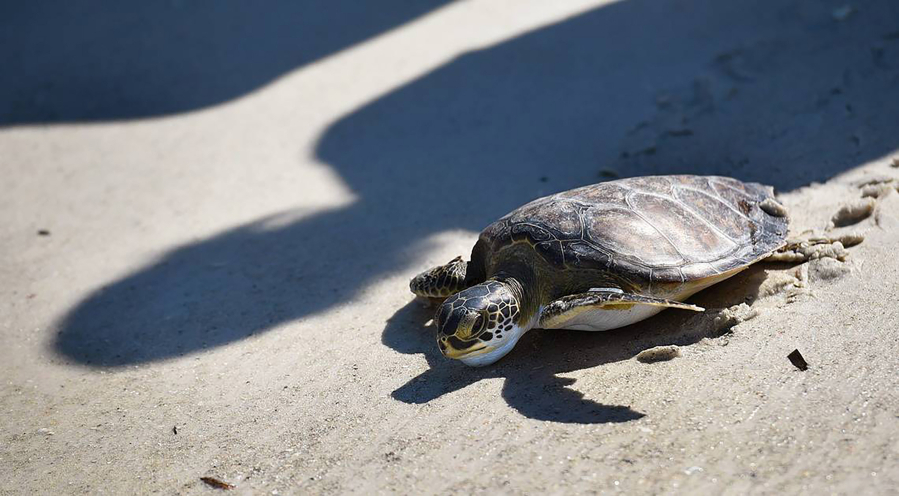MIAMI — The biggest journey in a sea turtle’s life is in the first steps it takes. They face obstacles like bright street lights, hungry seabirds or raccoons and, once in the water, commercial fishing nets or stray plastic they mistake as a jellyfish snack.
But now, leatherback sea turtles face another risk, according to a new Florida Atlantic University study — rising temperatures from climate change.
“This is a real concern with climate change because there’s already fewer leatherbacks than other turtles, they already have a lower hatchling success, but now we know they actually are going to be impacted by these higher temperatures,” said Sarah Milton, FAU professor of biological sciences and the senior author of the study.
Once a mature female sea turtle digs a hole in the sand with her back flippers, lays eggs and then covers them with sand, her parental duties are complete and the survival of the hatchlings depends on the conditions inside the nest. The warm sand acts as an incubator, responsible for keeping the hatchlings alive. The results of the study published in the journal Endangered Species Research revealed hotter sand lowered the odds of the turtles making it out of the nest and into the water.
Researchers looked at a total of 12 leatherback nests at Juno Beach; four nests each in the early, middle and late stages of nesting season. The day after eggs were laid, biologists removed half of the eggs and put a temperature logger, about the size of a salt shaker, into the center of the nest. The eggs were returned and temperatures were recorded every half-hour, day and night, for the entirety of the incubation period.
Once the sand is in the range of 93.2 to 96.8 degrees, as opposed to 87.26 to 87.8 degrees, the survival and ability for a hatchling to get out of the nest into water drops significantly, Milton said.
“The leatherback eggs were spending more time than we were expecting at high temperatures,” Milton said.
The study revealing temperatures make it more difficult for sea turtles to make it into the water is only a window to what is to come with climate change causing more frequent extreme heat. In 2022, the average global temperature was 2 degrees warmer than the 1881–1910 baseline, according to Climate Central.
The leatherback already has a lower hatching rate than other species, and biologists aren’t completely sure why. Overall, leatherbacks only hatch about 50 percent of the time compared to loggerheads at 75 percent during hot and dry summers.
Despite the species having a lower hatchling rate, researchers were still surprised by the results.
“We actually thought the nests would not get that hot because the leatherbacks nest mostly in March and April into May,” Milton said. “The season is not as hot and they lay eggs deeper, and the deeper you are in the sand the cooler it is. But I was very surprised by how hot the temperature of the nests got even in the early season.”
Looking at the evidence
They determined the hatch success by digging up the nest three days after the hatchlings emerged in what they call an evacuation. They counted the shells, checking for how many were laid, how many didn’t hatch and which were stuck.
The hatching success rate was 44 percent in the early season when the nest temperatures reached 92.48 degrees, over 69 percent in middle of the season when the nest reached 94.46 degrees and 49 percent in the late season when the nest reached 95.72 degrees.
“It’s amazing how a few degrees makes such a huge difference,” Milton said.
Fitness test
Just because a sea turtle hatches out of its egg, it doesn’t necessarily mean it will have the strength to make it out of the nest.
The leatherbacks in the hottest nests didn’t crawl slower but were less coordinated. In a test to flip themselves over from their back to their front side, hardly any of them could do it. Across all of the nests, 30 percent of 119 hatchlings could not right themselves even one time.
The late-season leatherback eggs were smaller because eggs develop quicker in the heat, giving less time for the yolk to turn into tissue. Smaller leatherbacks were more clumsy, while leatherbacks in cooler temperatures produced longer hatchlings better equipped to make it to sea.
Hatchlings from the highest nest temperatures had shorter flippers compared to hatchlings from midseason nests that had longer flippers.
The highest concentrations of leatherbacks in the U.S. are around Jupiter and Singer Island. Milton suspects one reason they are the first to study temperature impacts on leatherback hatchlings in the U.S. is because there are only hundreds of nests compared to the thousands upon thousands of loggerhead nests.
The solution isn’t as simple as finding ways to cool the nests with water or shade, Milton said.
“When you think that maybe one in 1,000 or even 5,000 make it to adulthood, you’d have to cool off 50 nests to maybe have one make it to adulthood,” Milton said. “So you just can’t do it on a practical scale, no one has the time and manpower to do that … They just don’t need the disadvantage of rising temperatures from the get-go.”



